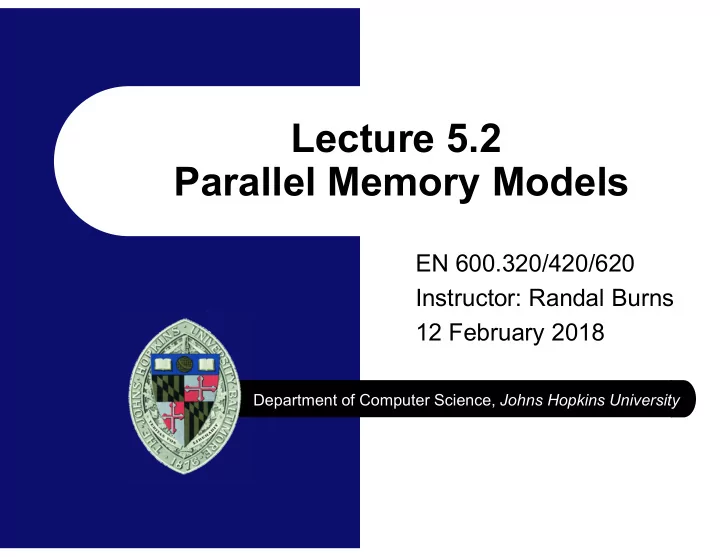

Lecture 5.2 Parallel Memory Models EN 600.320/420/620 Instructor: Randal Burns 12 February 2018 Department of Computer Science, Johns Hopkins University
Shared Memory Systems Large class defined by memory model – And thus, the programming model Shared-memory programming – Threads exchange information through reads and writes to memory – Synchronization constructs to control sharing – Easy to use abstraction Examples – OpenMP, Java, pthreads Lecture 3: Parallel Architectures
Symmetric Multi-Processor (SMP) Shared memory MIMD system – All processors can address all memory Symmetric access to memory – Performance statement SMPs have scaling limits On symmetry – SMP not symmetric to caches – Multi-core (symmetric to L2, not L1) https://computing.llnl.gov/tutorials/parallel_comp/ Lecture 3: Parallel Architectures
NUMA: Non-Uniform Memory Access Shared memory MIMD systems Latency and bandwidth to physical memory differs – by address and location Same programming semantics as SMP https://computing.llnl.gov/tutorials/parallel_comp/ Lecture 3: Parallel Architectures
RB ’ s Take on NUMA Very difficult to program – The tools don’t help programmer account for NU – Easy to write programs that work correctly – More difficult to write programs that run fast But, all multicore is NUMA – Even SMPs today have NUMA properties – Because of cache hierarchy New programming tools to help in Linux – hwloc: https://www.open-mpi.org/projects/hwloc/ – libnuma and numactl: http://oss.sgi.com/projects/libnuma/ Lecture 3: Parallel Architectures
Message Passing Book calls these distributed memory machines – This term is deceptive to me Each processor/node has its own private memory Nodes synchronize actions and exchange data by sending messages to each other https://computing.llnl.gov/tutorials/parallel_comp/ Lecture 3: Parallel Architectures
Programming Message Passing MPI – The “ assembly language ” of supercomputing – Libraries that allow for collective operations, synchronization, etc. – Explicit handling of data distribution and inter-process communication Map/reduce and other cloud systems – New paradigm that emerged from Google – Divide computation into data parallel and data dependent portions – Better abstraction of HW. More restrictive. – MR, Hadoop!, Spark, GraphLab, etc. Lecture 3: Parallel Architectures
Hybrid Architectures When a message passing machine has SMP parallelism at each of its nodes – Book is behind on this trend: every machine is a hybrid How to program – MPI: ignore the SMP aspects – MPI + ( OpenMPI, pthreads, Java, CUDA, OpenCL ) Expensive, hard to maintain – Automated compilation https://computing.llnl.gov/tutorials/parallel_comp/ Lecture 3: Parallel Architectures
Recommend
More recommend